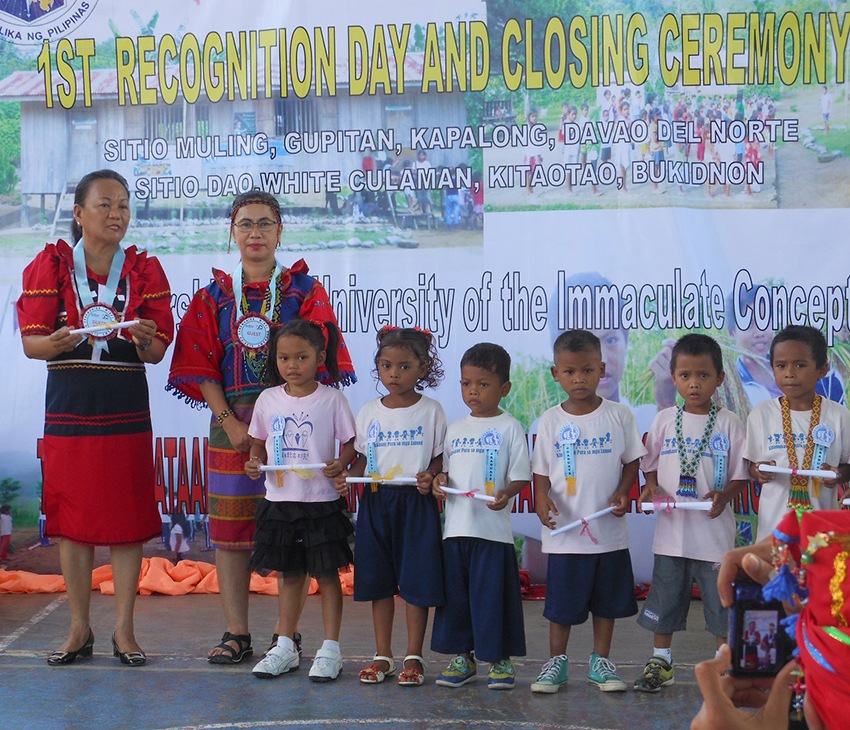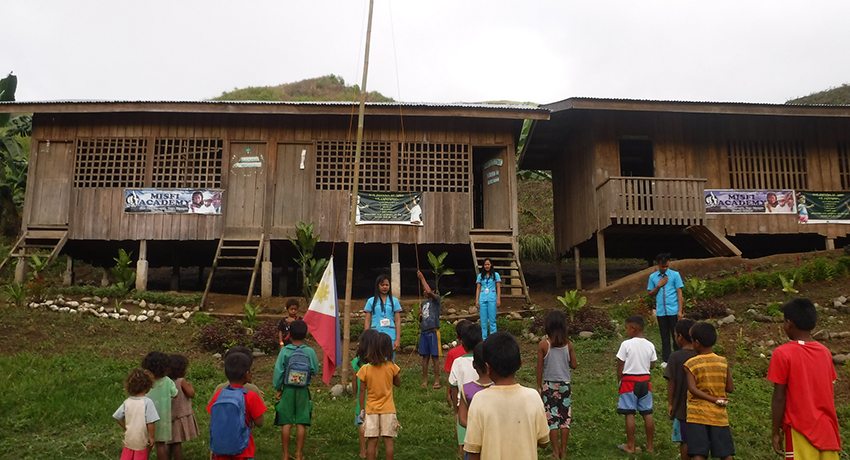
MISFI executive Director Percinita Sanchez and Community Education Coordinator Milagros Tan with Muling children during a recognition ceremony held in Davao City in 2016. (Fides Avellanosa/davaotoday.com)
They say being a teacher is a sublime calling, because the forming human faculties with knowledge and skills that would make it beneficial to society is no small thing and is a very challenging undertaking. For one, it is unlike the regular office job wherein one is only required to render at least eight hours of service each day.
The teacher however, goes beyond the eight-hour daily routine. Every one of us is aware just how tedious mentoring really is because then, the mentor does not start and end her or his mentoring in the classroom.
From preparing the lesson plans, test questions and planning for daily activities which is usually done late at night, to the actual teaching each day, teacher is likewise expected to attend to various other classroom and school concerns that are required by school authorities and the Department of Education from them.
Oftentimes, it is not only the child that she teaches but the whole family as well, as she also has to look into every individual child’s performance. It is not only the individual education needs of the child that she has to cater to, but those of the whole community as well.
This is the endless woes of mentors wherever in the world. However, the Lumad teacher had to face even more challenges than her or his counterpart in the lowlands.
While teachers in the town centers and the cities have to face their daily fare with more effort, the Lumad teachers have to double their efforts in trying to impart knowledge to the children of Indigenous Peoples. They struggle not only with their pupils and students, but with the whole community as well.
Teacher, first and foremost, must be sensitive to the situation in the community where the children are located, since, no knowledge can be imparted in a situation where the whole community is not peaceful, or is undergoing some kind of political strife that affects each and every member of the whole community.
Thus, whenever needed, they go to where the community is, because they have to perform their duties, no matter what happens.
As exemplified by the decades-long struggle of the Ata-Manobos in Talaingod and Kapalong areas where the IPs are constantly being driven out of their communities because of the age-old capitalist interest in their lands, the Lumad teachers’ lives seem to be hanging in the balance.
While the DepEd boosts of its Indigenous Peoples Education Program (IPED) under DO 3, s. 2017 – Multi-Year Implementing Guidelines on the Allocation and Utilization of the Indigenous Peoples Education Program Support Fund, some IP schools run by private organizations are so wanting of DepEd’s support.
Teachers of the privately-owned and run Salugpungan Ta Tanu Igkanugon Community Learning Center (STTICLC) and the Mindanao Interfaith Services Foundation Inc. (MISFI) even decry the seeming efforts to discredit their schools which are genuinely serving several IPs in Mindanao.

A MISFI school in Pangalay-ayan, Kitaotao Bukidnon starts their day with a flag ceremony. (Fides Avellanosa/davaotoday.com)
It is no secret that even President Duterte mouthed threats against the Lumad schools after being fed with malicious information by his Armed Forces regarding allegations that the schools are purportedly run by rebels.
Such preposterous claims which are baseless and without solid evidence are still being circulated to the detriment of the community and Lumad teachers whose lives are being endangered.
Still, it is worth noting that many among Lumad teachers refused to be intimidated by such allegations, but instead they continue to serve the IP children despite the threats on their safety.
This sets Lumad mentors a notch higher over their counterparts in regular schools. They continue to persevere because of genuine love for the Lumad children whom they consider as the poorest among the poor due to their situation and status in life.
Thus, it is hoped that the Department of Education be more humane in advancing their own programs for the IPs instead of being selective in its approaches. It has the mandate of the Filipino people to respond to the education needs of every Filipino child, without discrimination of whatever colour or creed or tribe that the child belongs.






